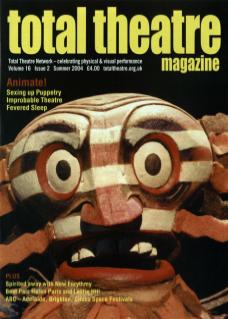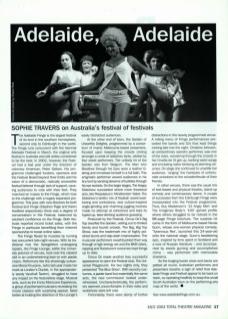The Adelaide Fringe is the largest festival of its kind in the southern hemisphere, second only to Edinburgh in the world. The Fringe runs concurrent with the biennial Adelaide Festival in March, the original arts festival in Australia and still widely considered to be the best. In 2002, however, the Festival had a bad year under the direction of visionary American, Peter Sellars. His programme challenged funders, sponsors and the Festival Board beyond their limits and his vision of a democratic, radically accessible festival faltered through lack of support, causing audiences to vote with their feet. They marched en masse to the Fringe, which rose to the challenge with a hugely expanded programme. This year, with new directors for both Festival and Fringe (Stephen Page and Karen Hadfield respectively) there was a degree of conservatism in the Festival, balanced by ebullient confidence on the Fringe. Both festivals reported record ticket sales, with the Fringe in particular benefiting from internet sponsorship to boost online sales.
The Fringe flexed its muscles by running two concurrent late night venues. With its traditional hub the Spiegeltent undergoing repairs, the Fringe Lounge, within the University precinct of venues, took over the cabaret slot in an underwhelming lean-to with plastic chairs. Performers like the shockingly subversive Moira Finucane (who last year made her mark at London's Duckie, in the appropriately seedy Vauxhall Tavern) struggled to have any impact on the featureless stage. Musical acts, such as the Ennio Morricone Experience, a group of performer/musicians recreating the movie classics with surprising appeal, fared better at holding the attention of the Lounge's easily distracted audiences.
At the other end of town, the Garden of Unearthly Delights, programmed by a consortium of mainly Melbourne-based presenters, focused upon keeping the crowds circling amongst a corral of sideshow tents, orbited by free street performers. The unlikely hit of the Garden was from Belgium. The Man who Breathes through his Eyes wore a leather G-string and immersed himself in a full bath. This enigmatic performer wowed audiences in his tiny tent by sending streams of bubbles through his eye sockets. On the larger stages, The Happy Sideshow succeeded where more theatrical acts, like Peepolykus's Mindbender failed. The Sideshow's larrikin mix of freakish sword-swallowing and contortions, rave culture-inspired angle-grinding and charming juggling routines made no attempt at coherence and kept its hyped up, beer-drinking audience guessing.
Produced by the Festival, Circus Oz's Big Top dwarfed the Garden, selling out to thrilled family and tourist crowds. The Big, Big Top Show, was the trademark mix of highly polished stunts and slap-dash improvisation. The muscular performers swashbuckled their way through a high-energy set and the BMX riders, rapping and fluorescent costumes kept things up to date.
Circus Oz made another less successful appearance to open the Festival club, The Universal Playground. For two nights only, they presented The Blue Show. With raunchy costumes, a jazzier band but essentially the same acts, the new commission looked under-rehearsed. Uncharacteristically, the performers seemed uncomfortable in their roles and audiences were left cold.
Fortunately, there were plenty of further distractions in this heavily programmed venue. A rolling menu of Fringe performances preceded the bands and DJs that kept things rocking late into the night. Christine Johnson, an extraordinary operatic performer, was one of the stars, wandering through the crowds in her Cruella de Vil get-up, barking weird songs and emulating native birdsong at alarming volumes. On stage she continued to unsettle her audience, 'singing’ the hairstyles of unfortunate onlookers to the schadenfreude of their friends.
In other venues, there was the usual mix of text-based and physical theatre, stand-up comedy and contemporary dance. A couple of successes from the Edinburgh Fringe were incorporated into the Festival programme. Thus, Guy Masterson's 12 Angry Men and The Imaginary Body's 100 gained profile where others struggled to be noticed in the 88 page Fringe brochure. The surprise hit came in the form of Melbourne-based Nicola Gunn, whose one-woman physical comedy, Tyrannous Rex, launched this 24 year-old onto the national stage. Gunn's bewildering epic, inspired by time spent in Scotland and a love of Russian literature – and accompanied by elastic gurning and accomplished mime – was performed with memorable charisma.
As the bulging books close and backs are patted all round, Australian performers and presenters breathe a sigh of relief that Adelaide Fringe and Festival appear to be back on track, cooperating healthily to keep this small South Australian town on the performing arts map of the world.

